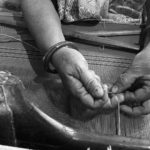Imagining the saree before the loom
The best Bajra roti that I ate was at the home of the brothers, Satish Chandra and Paresh Kumar Salvi.
Paresh Patel, who runs an Ashavali weaving studio in Ridrol had accompanied me to Patan. He told me that these two brothers– Satish Chandra and Paresh Kumar Salvi– were the only weavers in Patan who did all the processes by themselves: the tying, dyeing, and of course the weaving.
When we showed up at their home opposite a leafy mango orchard, the two brothers were upstairs, sitting beside a bed with a pink bedsheet, tying threads at salient points on the warp. We got talking. They talked shop and politics and then invited us back for lunch.
“Just simple home made bajra roti and sabzi.”
I enthusiastically agreed and we left to meet a mashroo weaver. One of the brothers, Paresh Kumar, followed us on his scooter. Turns out that he was going to the market to buy vegetables for our lunch. Talk about fresh food.
When we returned, the two brothers showed us the weaving technique. There was something about their pace, generosity and spirit that was alluring.
After observing the processes, we went into the kitchen, sat at a modest dining table and had bajra roti, peas sabji, jaggery/gud, and chhaas/buttermilk. It was among the most delicious meals I have eaten, in large part because of the warmth of the hosts.
We didn’t speak the same language, but they pressed food on me nevertheless. Isn’t that so typically Indian?





